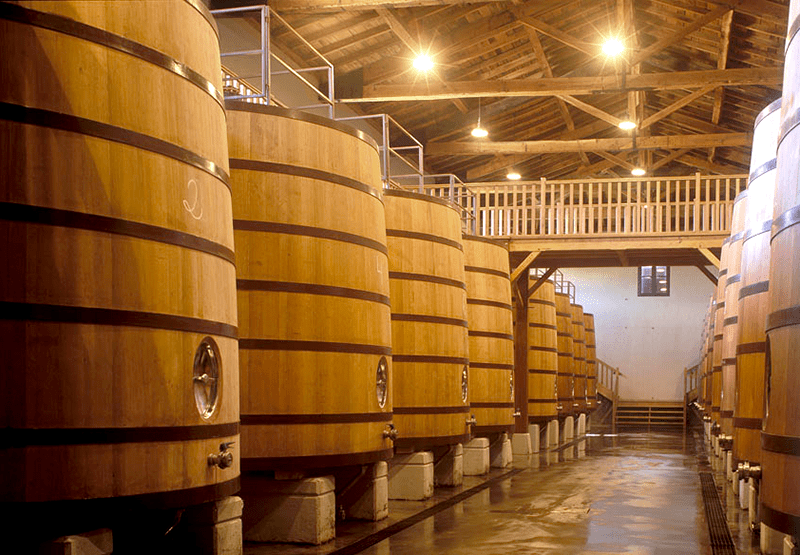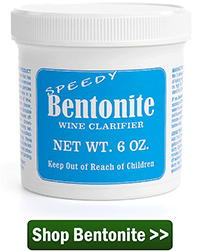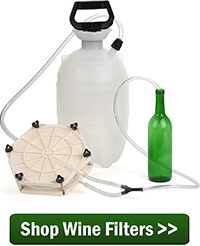 We look forward to and enjoy your email newsletter and have learned a lot from your subscribers’ questions. Now one of our own…
We look forward to and enjoy your email newsletter and have learned a lot from your subscribers’ questions. Now one of our own…
On a stop on a recent Missouri winery tour was an area for cold aging, where wine coming off secondary fermentation was chilled in the fermenter to around 28 degrees to help dissolved chemicals and remaining suspended yeast cells to fall out of solution before the wine was siphoned off into oak barrels. We don’t see this step in home wine recipes. Is cold aging beneficial to small-batch wines? If so, should it be done in the secondary fermenter after yeast action has stopped, or can it be done after bottling?
Thanks as always.
Ed
_____
Hello Ed,
What you are referring to is something called cold stabilization in wine making. The wine is chilled down directly after fermentation to speed up the settling of wine yeast cells and other suspended proteins. The yeast cells will become inactive or dormant at lower temperatures allowing them to go to sleep, so to speak, and settle out.
Chilling a wine after fermentation also causes any excess acids in the wine to form into crystals and fall out. This is known as acid precipitation. If the grape harvest that year was too high in acid, or to tart, bringing the wines temperature down will cause this excess acids to crystallize and then drop out as sediment.
Cold stabilization is only done in wine making after the fermentation has completed and the wine has been given a day or two for the heavier particles to fall out on their own through gravity. It’s a way of making the wine temperature stable so that bad things don’t happen after the wine has been bottled.
If the wine was too high in acid the cold stabilization process were skipped, acid crystals could start to precipitate out later on in the bottle, even while sitting in someone’s wine rack. Acid precipitation would be an absolute disaster for a winery, but not so much for the home winemaker.
Cold stabilization is beneficial if you are making wine from fresh fruits, and most beneficial when making wine from fresh grapes. If you are a home winemaker who is making wine from grapes every year, then yes, you might consider putting your wine through cold stabilization and chilling it down to for a few days before bottling or bulk-aging.
For most home winemakers though, this is not a process that can be practically accomplished. And that’s okay. Realize that there are many commercial wineries that never ever chill there wines. There are other ways of controlling excess acidity. And there are other ways to drop proteins out of a wine – time being one of them.
If you are making wine from wine concentrates or wine ingredient kits, then cold stabilization is pointless. This is because the acids have already been adjusted by the producer to make sure acid precipitation does not occur. There are no protein solids from any fruit to deal with either. When dealing with these packaged wine juices the only thing to be concerned about are the yeast cells, and these will easily drop out fine on their own or with a little help from a fining agent such a bentonite.
There are no protein solids from any fruit to deal with either. When dealing with these packaged wine juices the only thing to be concerned about are the yeast cells, and these will easily drop out fine on their own or with a little help from a fining agent such a bentonite.
Chilling a wine down, aka cold stabilization, does have a place in winemaking, however as I think you can see, it’s a far cry from being an absolute must-have. Great wines can – and are – being made without such treatment. But with that being said, if you have a spare refrigerator and a bucket of wine, go for it!
Happy Wine Making,
Ed Kraus
—–
Ed Kraus is a 3rd generation home brewer/winemaker and has been an owner of E. C. Kraus since 1999. He has been helping individuals make better wine and beer for over 25 years.

Every winter in Missouri, after fermentation is complete, I place my carbols & tanks on carts, cover them with blankets and set them outside for 1-2 weeks when the temperatures are forecast to be near or below freezing. If night temperatures drop to 20 or below, I place a light for warming under the carts and turn it off when the temperatures rise back.
There is at least one large commercial winery that designed their tank rooms to take advantage of winter temperatures to reduce energy costs.
CS is really a “must do” if you are growing cold hardy reds such as Marquette which is very high in acid content. The good news is you probably live in a colder climate which means your refrigerator is your garage, barn or cellar.
For the home winemakers out there that want to avoid those unsightly “wine diamonds” after chilling your whites, I’d like to suggest my simple method that has worked for me in the past……get a round plastic tub (the ones you would typically use for keg parties) from a local home store (cost about $7.50), & 40 lb. bag of ice. Line the tub with a heavy duty 33 gal. trash bag. Pour in about 3″ of ice & set carboy into the tub. Pack the remaining ice around the sides, close the bag around the neck, & wrap whatever old blankets you have (moving blankets work great) all around for insulation. After a day or 2, the ice will melt rather quickly, as the wine was at room temperature, and you will need to add a second 40 lb. bag of ice, which should be enough to do the job. I just did a 6 gal. carboy of chardonnay & it took about 6 days & resulted in about 1/3 + cup of crystals. Rsck off the crystals while still cold.
All of us must be able to check ph and ta..if you make wine..but I have a large cooler I use when acids are high in my wine..but do the malalatic fermentation first…often called secondary formation… this will lower high acids..if low acid skip malalatics … if still to high you can use acid reducing crystals.. and the cold stabilization..I shoot for a ta less than .68 and ph of 3.4….in cold stabilization it takes 10 days to drop the acid..keep checking ta and ph…thus I use a cooler..usually in carboys…but you must rack the wine immediately after taking out of the cooler or outside as mentioned above..to be rid of the acids.. then age the wine in glass or stainless for 28 months to 32 months.. your wine will be great.. aging helps a wine be better before bottling.. have fun all…get good at checking ta and ph..your wine deserves it….T
2 weeks into secondary and with SG of 0.986 I feel that 99% of fermentation is complete. Am I OK to put the carboy in garage where I can expect to vary in temperature from 30 to 60 degrees? Reading some other comments this should be acceptable. I can wrap the carboy with blankets to help insulate and keep at a somewhat stable temperature.
The current batch is Elderberry, next up is Blueberry and finally Cherry. All of which are fruits that will be/have been pressed.
Happy New Year! I’ll start by saying I absolutely love your newsletters and tips, I’ve learned so much. My question is regarding cold storage. We’re redoing our basement and have to move everything out of my wine room. I have 9 carboys bulk aging waiting for a better time for bottling. Would I be able to store them in my unheated garage in Wisconsin for the winter or would this damage them somehow? Half of them are raspberry and watermelon, and the others are various kits (chianti, white zin, riesling).
Susan, it will not harm the wine but if too cool it will slow down the aging process. The cooler the storage temperature, the slower the wine will age. Although this is the general relationship between temperature and aging wines, there is still a optimal temperature range at which you would like to store your wines. This would be somewhere between 45°F. and 65°F. If you can’t store your homemade wine in this temperature range, then you want to get as close as you can.
Hello! Thanks for your response! The recipe i used was from your web site. These are the ones i have for years with great success! As a matter of fact last year i entered a Red Raspberry wine i made from my own Raspberries in the International Amateur Wine Competition in Vermont and was awarded a Gold Medal following your recipe!!! That tells me your recipes work!! Thank you for that. As far as my problem the grapes with the pinkish purple color and not wanting to clear were thawed out. My sg was 1.085 and now is .992. I used 40lbs of grapes and 4 gal of water and ended up with 6 gallon of wine. Was this to much water? I was going for 5 gal like your recipe called for. I wasn’t sure how much water to start with. I use frozen fruit a lot but had never done grapes that had been frozen. I could use your help on this problem! this was the fist time i messed up using your recipes! Thanks for all the great articles and helpful info you put out!
Novice here. From what I understand you want to take the alcohol content of your wine and divide by 2 and add 1 to determine what temperature to store it in. So if I have a wine at 15% then the temp has to be 20.3 °F. Is it safe to put a glass carboy in a freezer unit at that temperature?
Eric, I am sorry, we have never heard of this so we do not recommend following this method.
I just finished racking my 2020 wine (about 12 gallons) from homegrown grapes (Marquette and Frontenac blend). The sediment was very crystalline. I didn’t cold age, just my normal basement temperature. Is this a good thing or a bad thing? Many websites say that I need to to do a malolactic fermentation for these grapes because of the high acid content, but I opted not to do this. It tasted pretty good so far.
The crystals dropping out is a clear indication that the wine is holding as much tartaric acid as it can. This is a completely different issue that: “is the wine too tart”. A wine can be dropping out tartaric acid as crystals and still not be too tart.
Having said this, you do not want these crystal dropping out after bottling the wine, so you’d like to get it to happen before bottling the wine. This is a step known as cold stabilization. And as you alluded to, it is to simply chill the wine down as much as conveniently possible so as to get all the crystals to drop out now, before bottling, rather than later.